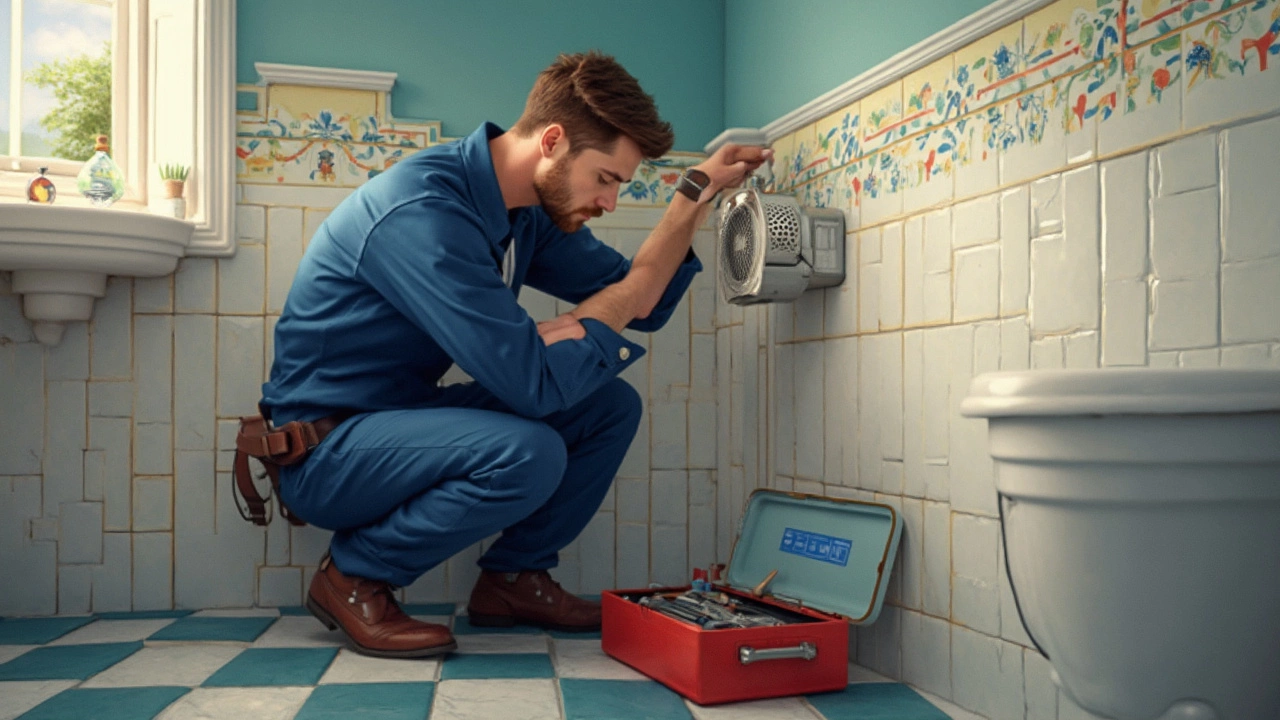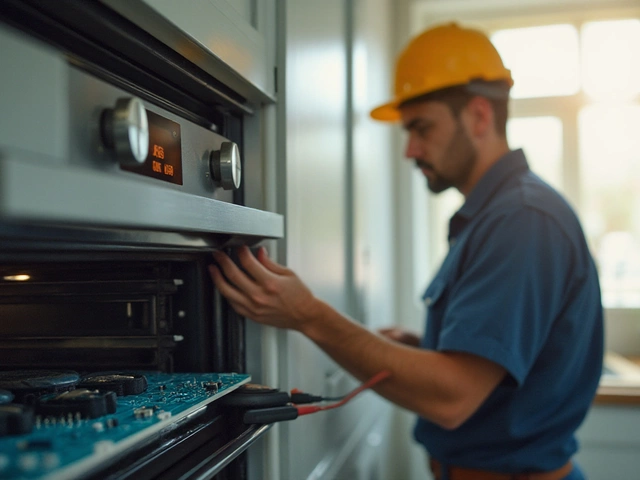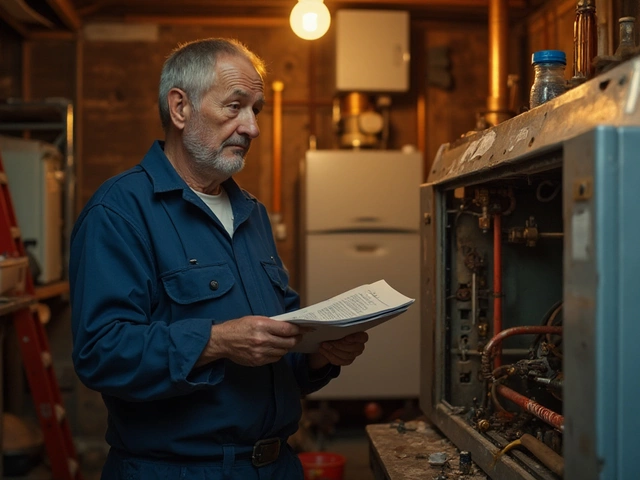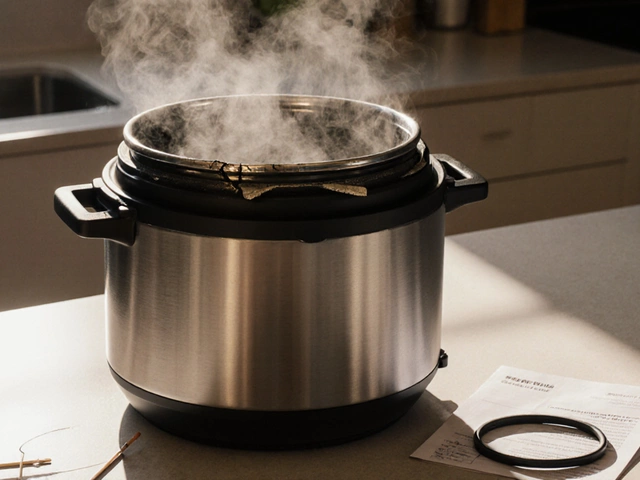Ever stood in a steamy bathroom, wishing you could zap away all that moisture instantly? That's where extractor fans come in, and they're life-savers. But who do you call when the extractor fan needs to be fitted or fixed? This has puzzled many, so let's clear it up.
In most cases, a qualified electrician is the one you need for installing an extractor fan. They know their way around electrical wiring, ensuring a safe and reliable setup. But wait, some handymen are skilled enough to handle this task too. It really depends on your location and the complexity of the job.
Here’s a cool fact: correct installation of an extractor fan can save you money on energy bills by preventing dampness, which leads to heating systems working overtime. So it pays to get the right person for the job.
Want to make the process smoother? Always check certifications and experience. And don't hesitate to ask for recommendations or read reviews. A bit of homework now saves headaches later.
- Understanding the Role of an Extractor Fan
- The Right Tradesperson for the Job
- Tips on Hiring and Working with a Pro
- Common Mistakes and How to Avoid Them
- Maintenance Tricks and Hacks
Understanding the Role of an Extractor Fan
Extractor fans are like the unsung heroes of our homes, especially in spaces like kitchens and bathrooms where moisture and odors can become a problem. Their primary job? To improve air quality by moving stale, humid air out and bringing fresh air in. This is crucial not just for comfort but also for preventing issues like mold and mildew.
A common choice for extractor fan installation is in bathrooms. Here, they combat the aftermath of hot showers, reducing moisture that might settle into your walls and ceilings, leading to damage over time. In kitchens, they help to vent smoke, steam, and lingering food odors, keeping the space pleasant and safe from grimy buildup.
How They Work
The mechanics are pretty straightforward. Most extractor fans have a simple fan that pulls air into the duct and then expels it outside. Some models even come with filters that catch grease or odors, adding an extra layer of function.
Energy Efficiency and Benefits
The right fan, placed optimally, can help in maintaining energy efficiency. For example, by minimizing moisture, you're also reducing the demand on heating and cooling systems, which can lead to noticeable savings on your bills.
Quick Facts
- Frequent use of extractor fans can extend the life of your paint and wallpaper by preventing peeling and fading caused by excess moisture.
- Modern models can include features like motion sensors or humidity sensors, kicking in only when needed, thus saving energy.
So, while they might not be glamorous, extractor fans play a pivotal role in maintaining a healthy, comfortable home environment. Think of them like your invisible line of defense against unwanted damp and unpleasant smells.
The Right Tradesperson for the Job
When it comes to getting your extractor fan installation or repair sorted, knowing who to call is crucial. An electrician usually tops the list. Since installing these fans involves dealing with electrical circuits, having a qualified electrician ensures the job is done safely and up to code.
What Makes an Electrician the Right Choice?
Electricians have the training to handle electrical wiring and can ensure your fan is installed without any risk of short circuits or fire hazards. Plus, they can advise on the best placement for maximum efficiency and even help with additional ventilation needs you might not have considered.
Can a Handyman Fit the Bill?
A skilled handyman can also tackle an extractor fan job, especially if it’s a simple installation or the existing wiring is already where it needs to be. Handymen are often less expensive than electricians but remember, their experience might vary. It's crucial to check their past work and customer reviews.
Finding the Right Professional
Here's a quick checklist to help:
- Always verify qualifications and licenses if you're hiring an electrician. It ensures they know their stuff.
- For handymen, reviews and recommendations are key. Ask friends or search local forums.
- Discuss all costs upfront. Some might charge by the hour, while others might offer a flat rate.
- Inquire about their experience with extractor fan repair—some specialize in this area.
In many places, the average cost for installing an extractor fan ranges from $200 to $500 USD. While it might seem like a big outlay, the long-term benefits of reduced moisture and improved air quality are worth it.
If your home setup is unique, you might face additional challenges like running ductwork or needing custom fittings. In such cases, always seek out a professional with specific experience in extractor fan installation.
Additional Tip
Need help deciding? Drop by your local electrical supply store. Often, product experts there can recommend trusted tradespeople they've worked with before.

Tips on Hiring and Working with a Pro
When it comes to setting up or fixing your extractor fan, getting the right tradesperson can make all the difference. Here are some tips to help you hire and work smoothly with a professional.
1. Do Your Homework
Before hiring someone, research is your best friend. Look for reviews online and ask around. Word of mouth recommendations are often gold. People love sharing good service experiences and warning about bad ones, don't they?
2. Check Qualifications
Ensure they have the right qualifications. If you’re looking at an electrician, they should be certified and experienced with extractor fan installation. This ensures they understand the safety codes and regulations.
3. Get Several Quotes
Don't settle on the first quote you get. It pays to compare. You might find a more competitive price or someone who covers additional services. Getting at least three quotes is a good rule of thumb.
"Selecting the right professional is crucial. It's not just about getting the job done, but getting it done right," advises John Elder, spokesperson for the New Zealand Electrical Contractors Association.
4. Discuss the Project
Once you've chosen a pro, have a conversation about what you want. Clear communication helps avoid misunderstandings. Show them the space, discuss fan options, and clarify any special requirements or concerns.
5. Agree on a Timeline
Set a realistic timeline for the project and make sure it's agreed upon. This helps you plan around the installation and manage any disruptions, especially if it's in a busy kitchen or bathroom space.
6. Inspect the Work
After the job is done, do a walkthrough with the contractor. Check that everything is working as it should. If anything seems off, now's the time to bring it up.
Extra Tips
- Verify insurance and liability coverage to protect yourself against accidental damages.
- Request a written contract detailing the work scope, time frame, and costs.
- Trust your instinct. If something feels off during your interview, it might be best to look elsewhere.
Following these steps can lead to a hassle-free extractor fan experience, getting you one step closer to a better-ventilated home.
Common Mistakes and How to Avoid Them
So, you're all set to get your extractor fan installation underway, but wait—there are a few common pitfalls people stumble into. Knowing these blunders can save you time, money, and a lot of frustration.
Incorrect Placement
First up is incorrect placement. Installing the fan too far from the main source of steam or odors can render it pretty ineffective. Ideally, place your fan directly above the shower or stove. This ensures it extracts moisture and smells efficiently. Always double-check placement with your tradesperson.
Wrong Size Fan
Bigger isn't always better. Choosing the wrong size can be a waste of energy. A fan that's too powerful could suck out too much air, affecting other ventilation. On the flip side, a too-small fan won't do its job properly. Consult the fan's specs or talk to your installer about the right CFM (cubic feet per minute) for your room size.
Poor Ventilation
Another hiccup is poor ventilation. Make sure the fan has a clear path to an outdoor exhaust, not just the attic. Venting into closed spaces leads to mold and mildew, which defeats the purpose of having a fan altogether.
Lack of Professional Help
Thinking you can do it yourself? Unless you're well-versed in wiring, leave it to the pros. This isn't just plugging it in and calling it a day. Incorrect wiring could not only damage the fan but also pose a fire risk. Hire a certified electrician or a qualified handyman with experience in repair.
Skipping Maintenance
And don't skip maintenance! A little upkeep goes a long way in ensuring your fan functions smoothly. Clean the grille regularly, and check for any blockages in the ductwork.
A study showed that homeowners who regularly maintained their extractor fans saw a 20% increase in efficiency over five years. That's energy savings you don't want to miss!
By avoiding these common mistakes, you'll have an extractor fan that works efficiently and lasts longer. So, think before you act, and consult with a pro when in doubt.

Maintenance Tricks and Hacks
Keeping your extractor fan in tip-top shape doesn't need to be a chore. Regular maintenance ensures it runs efficiently, helping to prevent the spread of mold and dampness in your home.
Regular Cleaning
First things first, give your extractor fan a good clean once every three months. Dust and grease can build up, especially in the kitchen, and this can clog the fan, making it work harder—meaning higher energy bills for you.
- Turn off the power before you start cleaning (safety first!).
- Remove the cover and let it soak in warm soapy water.
- Use a soft brush to gently remove dust from the blades.
- Dry all parts completely to avoid any moisture-related issues.
Checking the Fan's Functionality
Make sure your extractor fan is doing its job! A good test is holding a piece of toilet paper up to the fan. If it sticks, the suction's working well. If not, consider calling a tradesperson or checking for any blockages in the vent.
Be Proactive with Maintenance Alerts
Consider setting a reminder every six months to check all elements of the fan are secure and functioning well. Sometimes a loose connection is all it takes to stop your fan in its tracks. It’s these little checks that prevent big headaches down the line.
Here’s a bit of handy data on the efficiency of well-maintained extractor fans:
| Condition | Energy Efficiency (%) |
|---|---|
| Properly Maintained | 95% |
| Poorly Maintained | 65% |
With just a few simple steps, you're not only extending the life of your fan but also creating a healthier environment in your home. Plus, by keeping that fan spinning smoothly, you're dodging unnecessary wear and tear which can lead to frequent, annoying repairs. Keep these tips handy, and your fan will efficiently serve its purpose for years!





